POW 921, Author Mike Holt, an Interview/Lian-li PC-V354 Micro-ATX Case, a Review

|

Quick Click Links
Feature Photograph
POW 921, Author Mike Holt, an InterviewI Lian-li PC-V354 Micro-ATX Case, a Review
Photography News of Interest
Readers Submissions
Readers Questions A Snapshot of Bangkok Images Week in Review
Infocus Blog, CES 2011T
Feature Photograph *menu

Canon EOS 5 Mark II, 300mm F2.8L IS @F4.5 1/320th ISO 500
Some images I can view over and over again. This is one of them. What draws me to this image is the feeling of solitude and perhaps even loneliness. From his natural watchtower position he looks out over his sea ever alert for natures predators, while at the same time he basks in the late afternoon peaceful glow of a setting sun. Humans love watching sunset over bodies of water so I suppose we shouldn’t be surprised some animals appreciate the same.
But more, this image invokes a special memory. I was working with a client on a basic workshop and my assistant was in the back listening in for the hundredth time when she got the idea she’s listened enough and would rather play with the camera instead. I adjusted the settings for her, handed her the camera, and she was having a great time. The first time using a big telephoto and fast DSLR can be a lot of fun, and this was no exception. While working with my client I kept glancing back and occasionally asking her to make some captures for me. After all, there was probably zero chance of me getting my camera back that day..
These birds are elusive. You’ll see them but then they’re gone, rarely staying in the same place for longer than a second or two making them very difficult to photograph. And when you do see them, they’re hidden in brush or thickets and you rarely get a clear shot. So imagine my surprise when I spot this this guy perched on the rock looking over a large pond (his sea) with the sun warming his feathers, not moving at all. I remember saying rather frantically “get that bird, get that shot, arrrghh.. just get it..” and I heard the camera’s shutter cycle 5-6 times. At the time I had no way of knowing if she’d found the right focus, made decent framing, both would have been asking too much for someone’s first time. So imagine my delight when I downloaded my images later that evening to find this perfect image. What a treat!

Canon EOS 5 Mark II, 300mm F2.8L IS @F4 1/100th ISO 100
There are many interesting birds in Thailand. This particular image doesn’t share nearly the composition as the Feature Photograph above, but he’s still a lot of fun showing his colors and attitude. These birds hang out with bears. They sit on their heads, share their food, clean the bears of lice and other small critters, and with the bears watching over them enjoy absolutely no other predators. A satisfying life I’m sure.
These images are significant because they show more than “a bird.” They show a bird in an interesting composition above, and a bird with an attitude. Both add interest. Everyone photographs birds sitting still, birds flying, birds eating. You need more. You need to photograph them in an interesting theme. Give it a try!
POW 921, Author Mike Holt, Interview *menu
Mike Holt has been a friend for several years. A talented and often controversial writer, his collection of short stories are rarely boring. Last year he contacted me asking if I had any images from the Death Railway are of Kanchanaburi because he was writing a book about a fellow Australian who had lived through the hell of the Japanese POW working camps both in Thailand and Japan. I was happy to provide the image used on the cover in the hope it would motivate others to pick this book from the stacks and learn more about what it was like to be a POW during the WWII era.
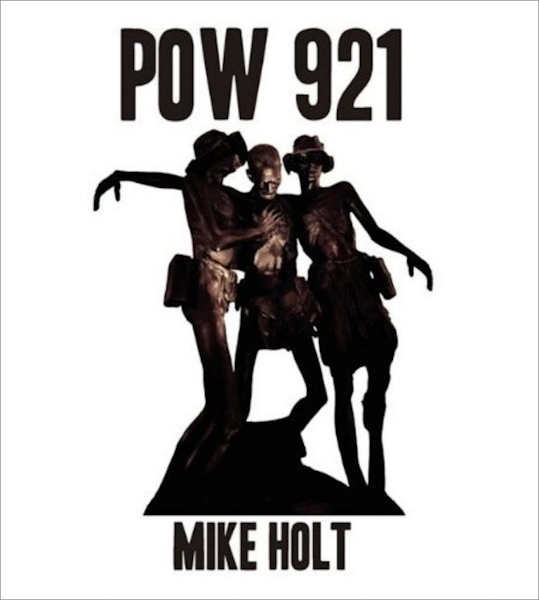
BkkSteve:
Marc or is it Mike?
Mike Holt: Mike….I reverted to Mike when I returned home. My real name is Michael, but the Thais heard Marc when I spoke with my Aussie accent, so I went with the flow and became Marc.. I thought the
'C' was more classy.
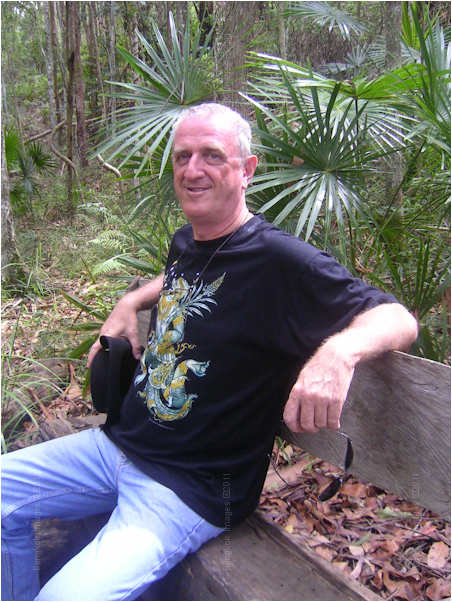
BkkSteve:
I’ve always wondered about that, most of us here know you as Marc. You lived In Thailand over 30 years?
Mike Holt: Yes. I went there for a week's holiday and never left, the longest holiday I’ve ever had.
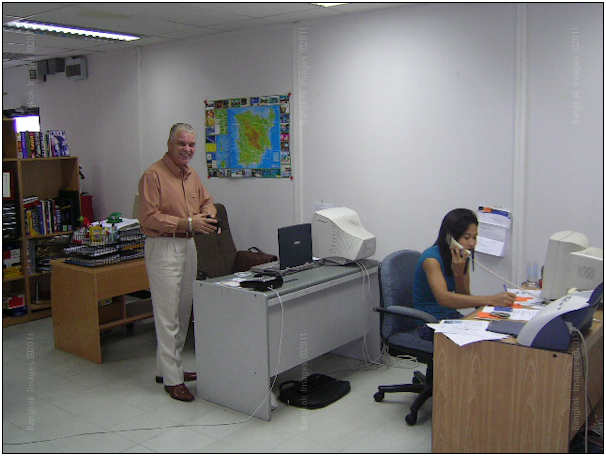
BkkSteve:
I'm not going to ask about your personal life other than to ask how your wife and two girls are doing, but could you tell us about your professional life In Thailand over those 30 years?
Mike Holt: Like many, I started out teaching English. In those days there were very few schools and the pay was awful. I started working for Thong-in Phone who tried to rip me off. Then I got a job working for an American for a while. After that, I started my own school which did very well for 10 years. Then my wife and I broke up and I sold the business.
After I bummed around Thailand for a while I joined Betagro Computer as Technical Manager, managing a team of about 12 Thai software developers. I did that for 3 years, then started Holt WorldWide in 1997, the year of the big financial crash. Mine was one of the few IT companies that survived. I ran Holtww for about 10 years and sold it In 2008 to return home.
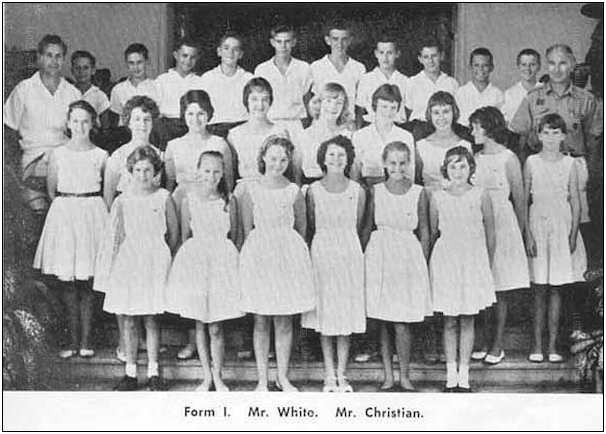
BkkSteve:
A few weeks back I met a young American who was starting an English school over in the Ramkamhang area close to the university. Do you think it's easier or more difficult to start a language school today as back when you did it?
Mike Holt: Probably about the same. If you work hard and do it right, you can still do well today.
BkkSteve:
That's good to know. 30 years is a long time in any country and I'm sure it takes a lot to prosper for that length of time in Thailand. One of your skills is writing. I’ve been a fan of a few of your writings for some time. Can you tell us about them?
Mike Holt: Yes, I’ve been writing ever since I can remember. My first published work was In the RAAF School Penang year magazine In 1962 called "A job In the army is what I want." I’ve written lots of stories for magazines, newspapers, and various other publications, as well as about 130 short stories for various websites. The short stories are mainly about my life In Thailand, but also some fiction, and some political essays.
BkkSteve:
This jogs my memory. You went to high school In Malaysia?
Mike Holt: Yes. My dad was In the RAAF at Butterworth. I’ve spent about half my life living In Asia.
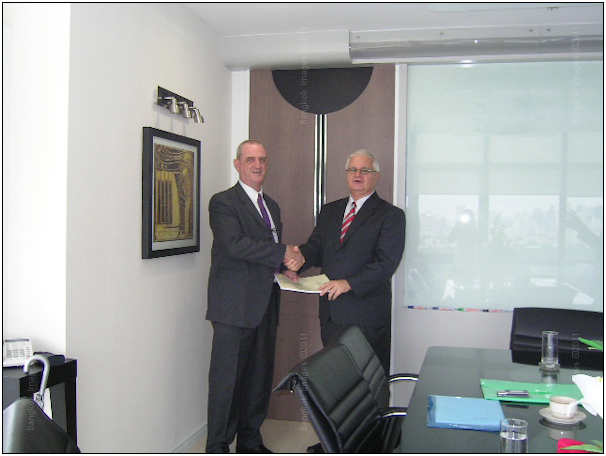
BkkSteve:
And you saw military service In SEA?
Mike Holt: Yes, I was posted to RAAF Ubon, in the NE of Thailand In 1967. I have written a few stories about this for a local website.
BkkSteve:
What an interesting life! I can relate somewhat to spending most of my adult life In Asia.
Mike Holt: I’ve been very lucky. Never a dull moment.
BkkSteve:
One of my favorite series of yours was written under "Foster Foskin", the only series equally entertaining was the adventures of Professor Earnshawe.
Mike Holt: Yes, that very entertaining series was written by Mick. Soon after he published Professor Earnshaw, he 'disappeared' after moving to Italy to teach. I tried several times to contact him, and finally he got in touch this week. I exchanged emails with Mick 2 days ago for the first time In a few years. He's In Europe somewhere. He has offered to send me some of his latest writing. I'm looking forward to that. He's a brilliant writer. He invented the name Foster Foskin. I loved it so much I immediately sat down and started writing what turned out to be a 20 chapter series.
BkkSteve:
Both are very entertaining. I’ve yet to be clued In as to the identity of this talented writer, but needless to say he has a huge fan base as you yourself enjoy from the Foskin series.
Mike Holt: Can't say too much about him as he values his privacy, but he's a Brit called Mick. We only met a couple of times before he left Thailand. I'm hoping we can meet up again sometime. He's a very intelligent and entertaining chap.
BkkSteve:
I first visited Kanchanaburi and the war cemeteries, death railway museum, and the bridge over River Kwai four years ago. I couldn’t help but feel moved during my visit. The feeling you get visiting the place can't be described. Mr. Rod Beattie, the curator and owner of the Death Railway Museum was kind enough to allow me to photograph inside the museum and told me a lot of the history.
Mike Holt: Wait until you read POW 921. When I was interviewing Colin he kept on telling me that no matter what he told me, it couldn't even touch the actual situation. I couldn't believe anyone could live through all that pain and suffering and still remain sane. Colin was an amazing man. He was 89 when I met him, and he died a year later, just after I'd finished the book.
I think he held on until it was written so that he could be sure the world would find out what it was really like. I have walked along the railway, seen the wooden trestles Colin cut from the jungle, and even followed where the track used to be far into the jungle. Did you know that the Brits tore up the track from Sai Yok Noi after the war and sold the steel? They were determined to make as much money out of the war as possible, even to the extent of ripping off Aussie sheep farmers. They paid the farmers a pittance for wool during the war and hoarded it. Then they sold it for an enormous profit after the war. Colin was very bitter about that.
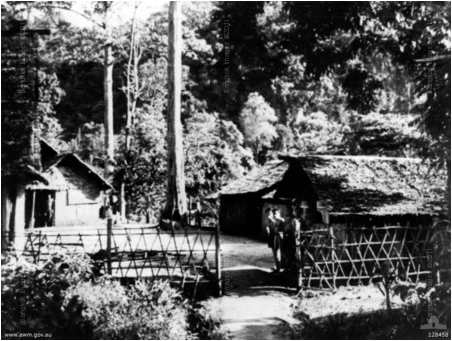
BkkSteve:
I'm looking forward to it. I’ve read a couple biographies after my visit inspired more research, but you were able to live close to this man for some time?
Mike Holt: Yes. He was my next door neighbor. When we moved into our first house after returning home from Thailand, his wife welcomed us to the neighborhood and that's how I met him. He gave me his memoirs to read and I was so intrigued I asked him if I could write a novel based on his experiences. So I changed his name and wove in a love story throughout the book as well. It all ties up very nicely at the end. I have included a list of most of the POWs who were imprisoned with Colin in Japan.
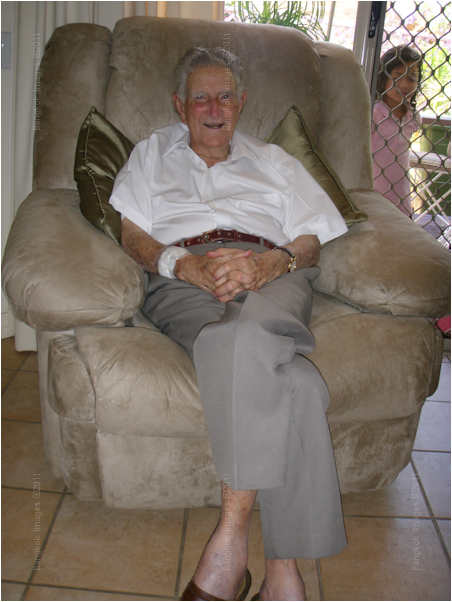
BkkSteve:
Were his memoirs published or personal?
Mike Holt: Personal, although he printed up about 1,000 copies and sold them to friends and other people who knew him or knew of him. He also had a few newspaper articles written about him that just skimmed the surface.
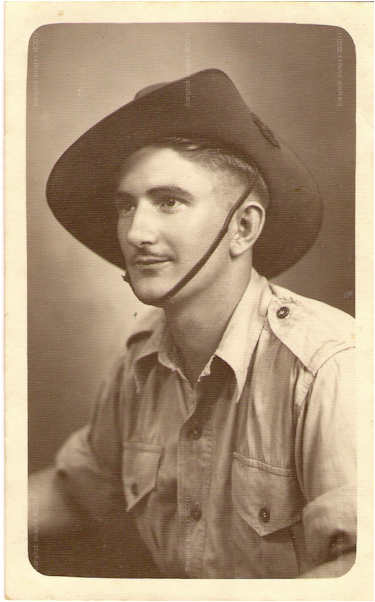
BkkSteve:
What was the man like?
Mike Holt: He was very gentle, and he hated war. He was also an adamant atheist, so we had plenty in common. I didn't know it at the time but he had cancer when I met him and he must have been in considerable pain, but he never let on. He was an incredibly brave, stoic man.
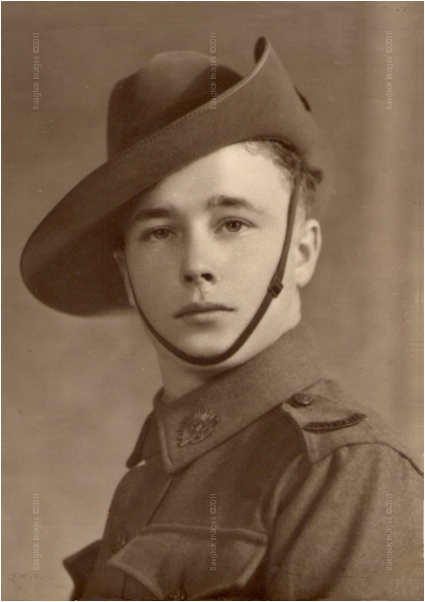
BkkSteve:
So he "inspired" your book POW 921, but the story In POW 921 is fiction?
Mike Holt: The book is certainly inspired by him, and most of the events are based on what happened to him. It's semi-fictional. where I talk about events in the war, or historical incidents, they are true. It shouldn't be hard for the reader to pick what is real and what is fiction, although some events are actually based on my own war experiences too.
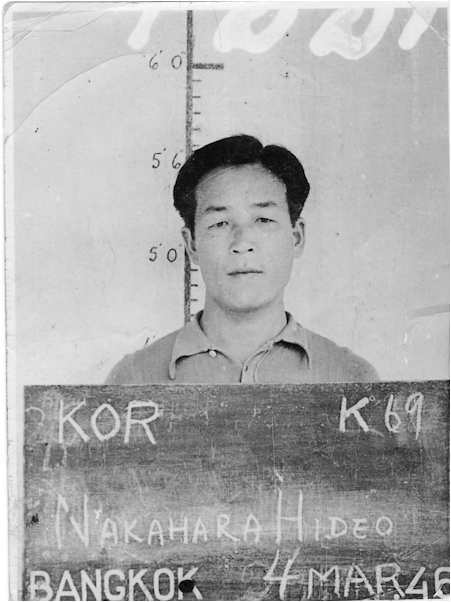
BkkSteve:
I can't think of a better way to gain information for such a book than to spend time with a man like this. I’ve been privileged to know a few POW's from my time working at the Veterans Administration, and to a man they were kind and quiet, didn't like to talk much about their military life. Was your man like this, and if so how did you get him to open up and talk?
Mike Holt: Yes, he was very quiet. In fact, I was very lucky that he took a liking to me almost from the start. His wife said that he told me things he hadn't even told her! So I was very privileged to know him. My wife and I both loved him. It was very sad when we had to attend his funeral.
Yes. We understood each other. Although I didn't suffer anything like he did In the war, we shared a common bond because of our war service. I would go over to his place at least once a day, sometimes more. And my wife worked for him and his wife cleaning the house and doing the washing/ironing. So we developed a close bond with them. Everything just flowed from there.
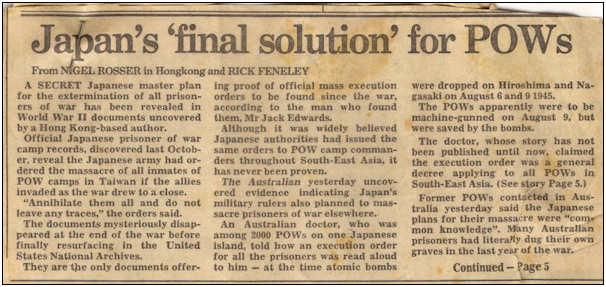
BkkSteve:
He must have felt he could relate to you, or that you two shared some common ground. Mr. Rod Beattie explained to me that over 2800 Australians were buried at the two war cemeteries in Kanchanaburi, beautifully maintained, and that recovery of their bodies was made difficult because during the period they'd make cemeteries by each camp which later had to be found?
Mike Holt: Yes, that's true. Often the POWs who died were flung into the jungle or buried in graves at the work camp where they died. Sometimes, tigers roaming In the jungle got at the bodies. I doubt that all the bodies have been recovered. Did Mr. Beattie mention this?
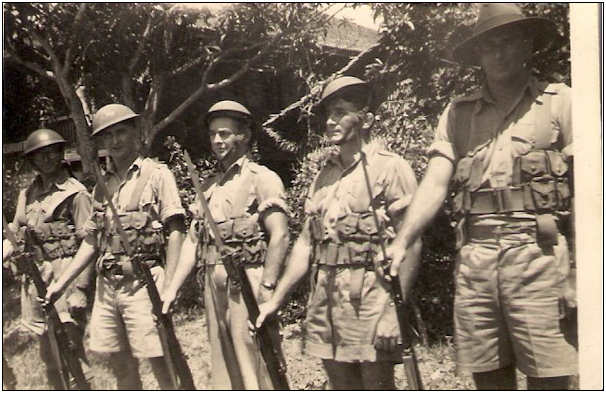
BkkSteve:
Yes, he said it was his lifelong endeavor to find as many of the bodies as he could and inter them In the cemeteries in which he is the caretaker. He spends a lot of time along the old rail collecting artifacts and gaining information as to the whereabouts of these men. Can you relate to us a few stories Colin told you about his own experiences?
Mike Holt: After the 3rd chapter, which describes the fight for Singapore and the surrender, Colin was interned In the old British officer barracks near Changi. He was put on work details for about 1 year, delivering rice to the Japanese garrisons, or building a road. They had to level the top of the hill using just chungkol's, a kind of hoe. The japs built a war memorial to their fallen troops. But as Colin said, he could never understand them. They also built a small memorial at the back of the Jap one to honor the fallen Allied troops.
The Japs were especially cruel to the Chinese, despite this, the Chinese Singaporeans would often do what they could to alleviate the pain and suffering of the Allied troops. One little old lady put two buckets of water on the road as the POWs marched past. The japs didn't see her do it at first, but when they saw the POWs drinking they chased the woman, beat her viciously, and eventually killed her. Colin said it was bravery like this that gave the men the courage to stay alive.
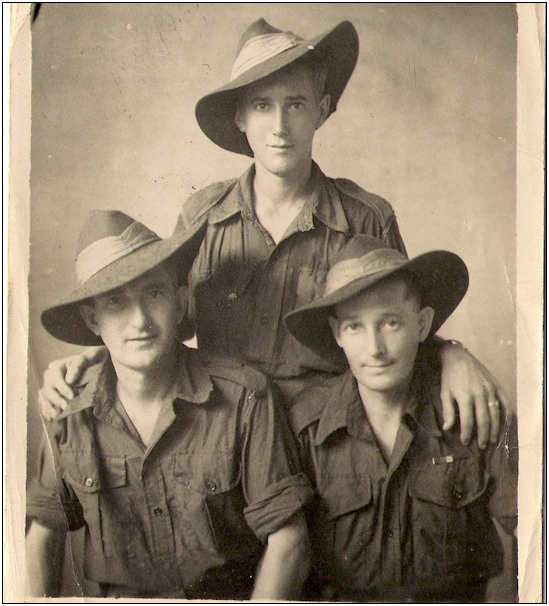
Perhaps the most harrowing part of the book was the trip from Singapore to Kanchanaburi. The POW's were crowded into steel carriages and left without food or water for the journey. The only break was when the train got over the Thailand border and it stopped to take on more water. The Japs let the men out and allowed them to wash in the water from the water tank. Imagine a bunch of emaciated men, many in ragged shorts, jumping in the stream of water as a bunch of incredulous Thais watch. The Thais had likely never seen a white man before. Colin described things like this to me all the time. Just little things that have given the book such a human touch. Considering the inhumane treatment the Japs dished out, the POW's were very resilient. I gained such a lot of respect for them as I wrote.
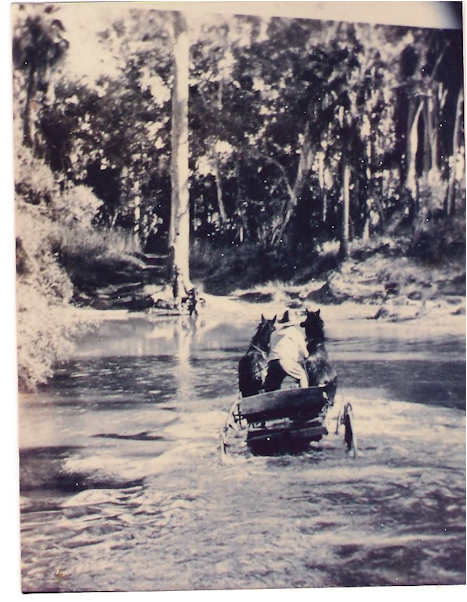
BkkSteve:
Wow.. I can imagine it would strengthen their resolve for sure. Changi is another "must visit" for those interested In the history or war In SEA, I spent a few weeks there myself. How old was Colin when he became a prisoner?
Mike Holt: Around 21. I can't remember exactly, the date is mentioned In the book.
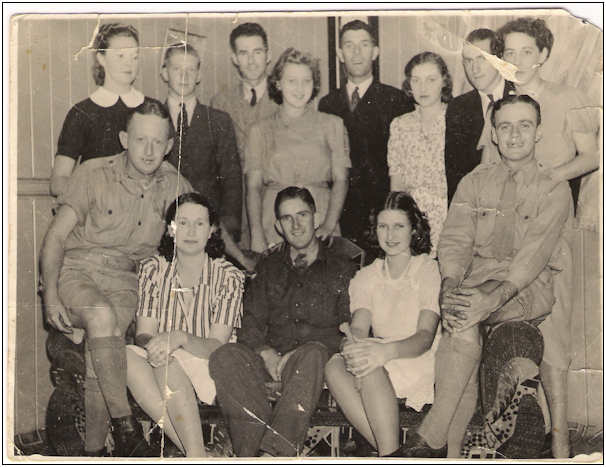
BkkSteve:
Still a kid In many respects, but a man for serving his country. Do you think his youth helped keep him alive?
Mike Holt: Possibly, but I think it was his resolve to stay alive, and the fact that he met some Malays before he was captured who taught him jungle survival skills. Things like finding out which plants were edible, how to alleviate thirst with a pebble In the mouth, how to use bamboo to make utensils, etc. He also realized that personal hygiene was very important, but even more important was boiling all his drinking water. He avoided dysentery and other diseases using these skills. The longer he was imprisoned, the more he hated the japs and that hatred kept burning deep down inside.
However, just before the Nagasaki bomb was dropped he almost lost his life. All the POW's were being starved to death, but what was shocking was that they discovered after the surrender that the Japs had been keeping all the Red Cross packages of food and other things.
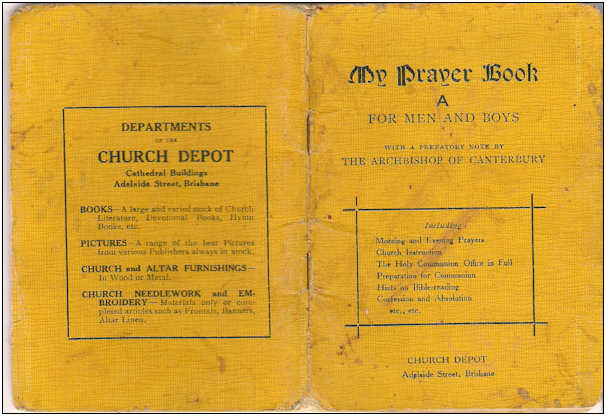
BkkSteve:
Shocking though not surprising. You said In the book he witnessed the Nagasaki bombing?
Mike Holt: Yes. He was working on top of a mountain about 35 miles away from Nagasaki, directly across the bay. They didn't know what the bomb was at first. They thought the Navy munitions dump had been hit by a bomb.
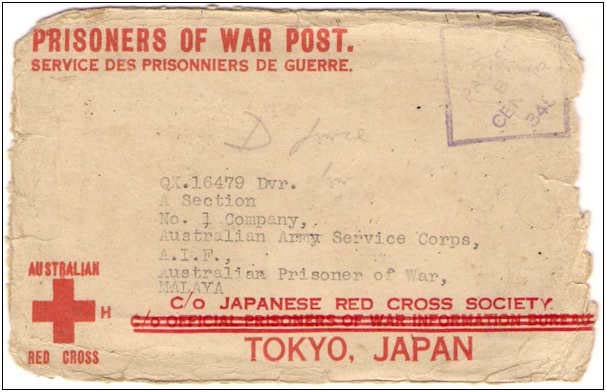
BkkSteve:
When did he get transferred from Thailand to Japan?
Mike Holt: The year before the war ended. They were shipped up there. They were very lucky they weren't torpedoed by allied American ships or submarines.
BkkSteve:
That's for sure. What an interesting story! In your book, who was he able to fall In love with? This isn't a Brokeback mountain story is it?
Mike Holt: Ha ha. No. He fell In love with a girl while on rookie training in Brisbane before he was sent to Singapore. I created the love story for the book, although the girl he fell In love with was real. But what is really funny is that on the last day he was In the army he met his wife-to-be although neither of them knew it. But his wife surely remembered his outburst just before he signed his discharge papers.
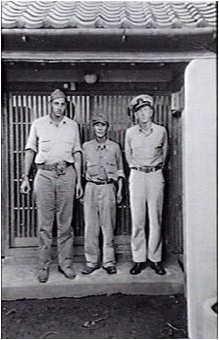
BkkSteve:
Outburst?
Mike Holt: Yes. He had been waiting around all day to sign his discharge papers, and just as he stepped up to the desk at 5 pm they told him that he would have to wait until the next day as the Padre had gone home. He got a bit upset and told them he didn't want to see no damn padre as he was an atheist and didn't give a damn about any god. Remember that this is a man who suffered terribly for his country and the pencil pushers treated him like rubbish when he returned home.
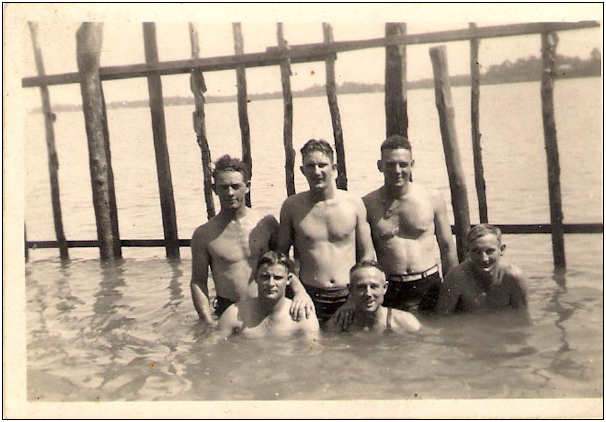
BkkSteve:
Hehe.. did they take the point?
Mike Holt: Nope. They made him wait overnight. There's another funny story after this episode, but read the book to find out what it is.
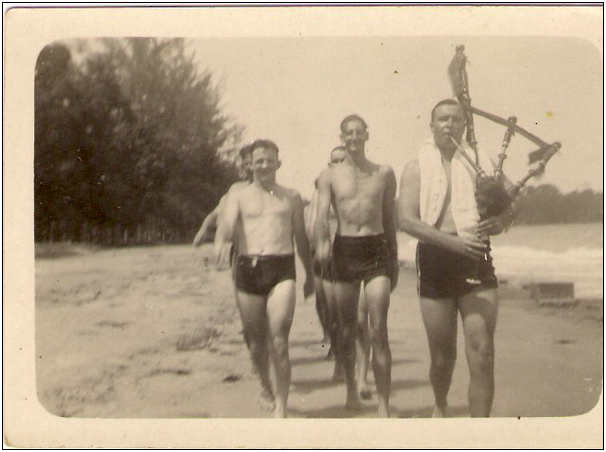
BkkSteve:
I sure will! One more question about Nagasaki. He was 35 km away. Did he suffer the effects of radiation?
Mike Holt: Strangely, no. He was showered with dust and cinders but it didn't seem to have any effect. Strange that.
BkkSteve:
Or maybe he was so used to pain and suffering he didn't realize it was affecting him. I’ve seen this phenomenon before..
Mike Holt: Nope. He returned home quite healthy and never seemed to suffer any after effects from radiation. However, it took him a long time to fully recover from the treatment he received from the Japs. He continued to suffer from Malaria, and it took a while for his ulcerated legs to heal.
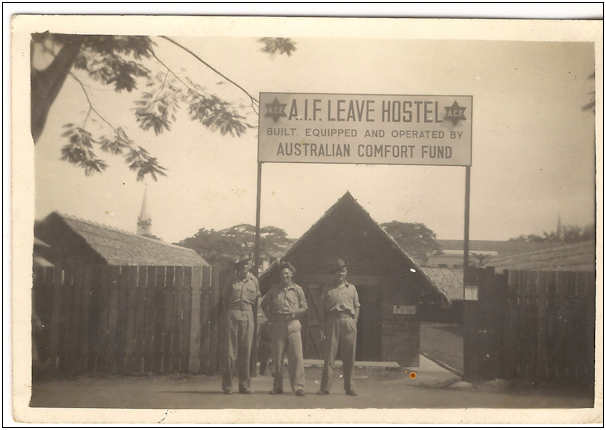
BkkSteve:
Marc, this has been a great interview and I'm sure the readers will want to read this book for themselves. I'd like you to have the last word(s) about anything you'd like to talk about or say?
Mike Holt: As you know, I write a lot, mostly short stories. This was my first book. Writing it was a very strange experience. Sometimes, as I described the pain and suffering Colin went through I had to stop writing. It was just too much for me, but I felt compelled to get the story down as quickly as possible. I knew he wanted the story told.
I'm glad it's published now. I know he would have loved to see it out there on the book shelves. He always told me that the story had to be told so that future generations would know what really happened to men like him. Some of his friends read the manuscript and they were as amazed at his resilience as I was. One of them told me that he read the book overnight and cried at the end. I hope that other readers feel the same way after they have read the book.
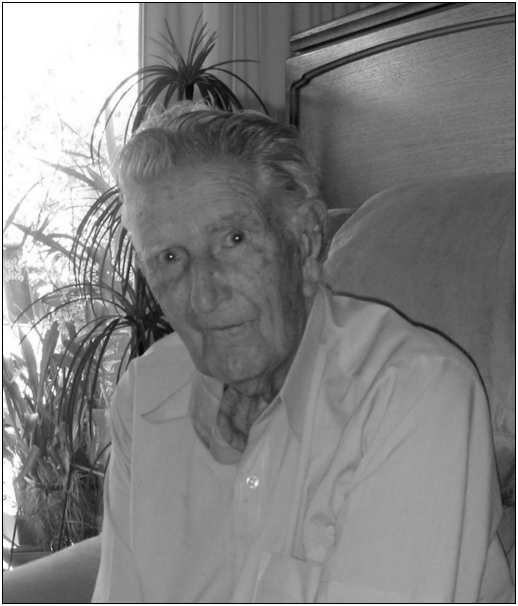
BkkSteve:
I admire your determination and respect for this man. Thank you Marc.
Mike Holt: Thanks mate. A pleasure.
POW 921 can beordered anywhere from Amazon # ISBN-10: 192179142X
# ISBN-13: 978-1921791420 or from within Australia here.
Lian-Li PC-V354 Micro-ATX Case, A Review *menu
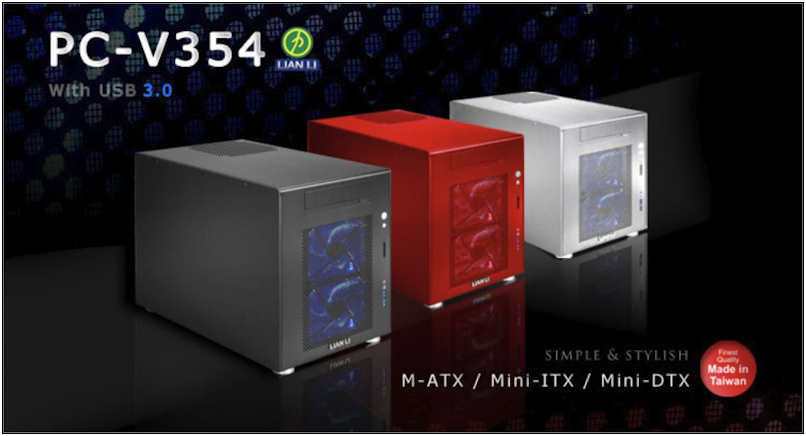
Introduction
Everyone who drives a car knows Rolls Royce stands alone as the epitome of 4-wheel luxury against which all other competitors are judged. They’ve set the standard. In the world of Personal Computer Cases Lian-li sets the standard. And there are even fewer legitimate competitors.
There are many arguments for purchasing a top quality case. Design and cooling ability, fit and finish, and perhaps the best reason is that a good quality case can be reused over and over again. Certain components of a PC are this way including power supplies, SSD’s, storage drives, they’re all reusable in a new build. Most “new builds” are nothing more than the upgrade of the motherboard, CPU, and memory. So the cost of a top quality case can be spread over several builds.
Lian-li makes many case styles and sizes, but this time what I wanted was the very smallest case that would still hold the most powerful available CPU, a full six banks of memory, a full size ATX power supply, and two of the largest most powerful video cards available. It must be small and light enough to be easily lifted and moved, and durable enough to be considered portable. There aren’t many such cases, perhaps 2-3 on the entire market. The PC-V354 stands alone as the only quality case to meet these requirements.
Features
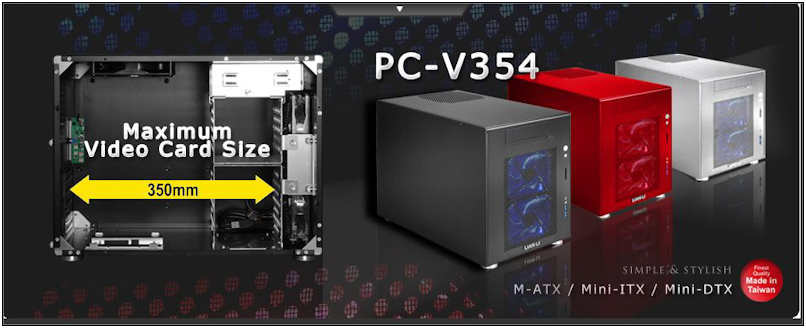
Size/Weight
This case stand a mere 12 inches (320mm) high, 9 inches (245mm) wide, and 16 inches (420mm) deep. Folks, that’s barely larger than a shoe box, at least for someone who has size 13 feet. 100% aluminum construction allows this case to weigh in at only 9 pounds. This means a fully loaded case, depending on how many drives you put in it, and the size of the power supply, will run from 15-20 pounds. As portable as I need, and suitable for those who use them for LAN parties or even a HTPC.
Motherboard
This case holds a Micro-ATX, Mini-ITX, or Mini-DTX sized motherboard.
Video Cards
Depending on your motherboard choice you can install a pair of the longest video cards such as the ATI Radeon 5970/6970’s. If you do so you must remove the bottom hard drive case losing the capacity of 4 internal HDD’s. Smaller cards like the ATI Radeon 5770 cards will easily fit with the cage intact.
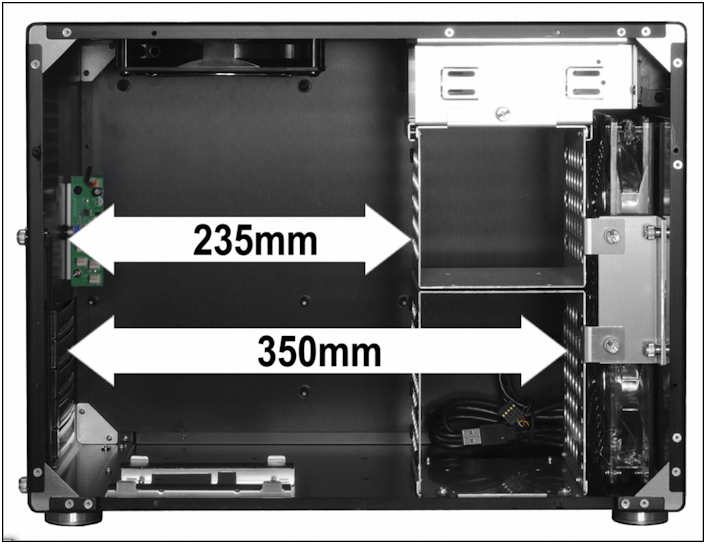

Storage Capacity
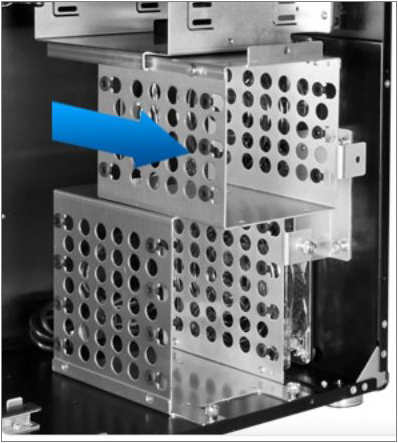
You have one optical drive bay, 8 internal 3.5 inch drive bays, and 4 2.5 inch drive areas. That’s a lot of storage. Assuming you use a SSD (2.5”) for your system drive, that leaves up to 8 3tb drives for a possible 24tb of internal storage. That’s a huge amount of storage. Installing the longest video cards results in losing 4 of the 3.5” drive bays.
Ports and Controls
The front panel hosts 2 USB3.0 ports which is a nice modern feature, a quality SD card reader, and on the rear panel an integral fan speed controller. There is also a power button that lights blue when the power is on, and a reset button that doubles as a HDD indicator. A greed LED lets you know the SD card reader is active.

Thermal Flow
Lian-li enjoys a great reputation for making cases that dissipate heat better than most others. They do this with a thoughtful design, in this case high quality fluid bearing 120mm fans in the front, pushing the air through the case to cool the motherboard/CPU/RAM, and then another high quality fluid bearing 140mm fan vents the heat out the top, and a 120mm fan out the back. There is a blank cut in the back with pre-drilled holes to mount a fourth internal case fan if you feel one is necessary.
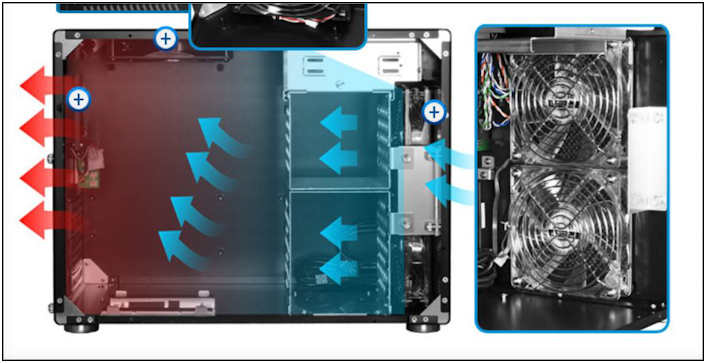
Power Supply
Most small form factor cases are limited by what power supplies you can fit. The PC-V354 holds standard ATX size power supplies of most any capacity. This allows you all the power you might need for your requirements.
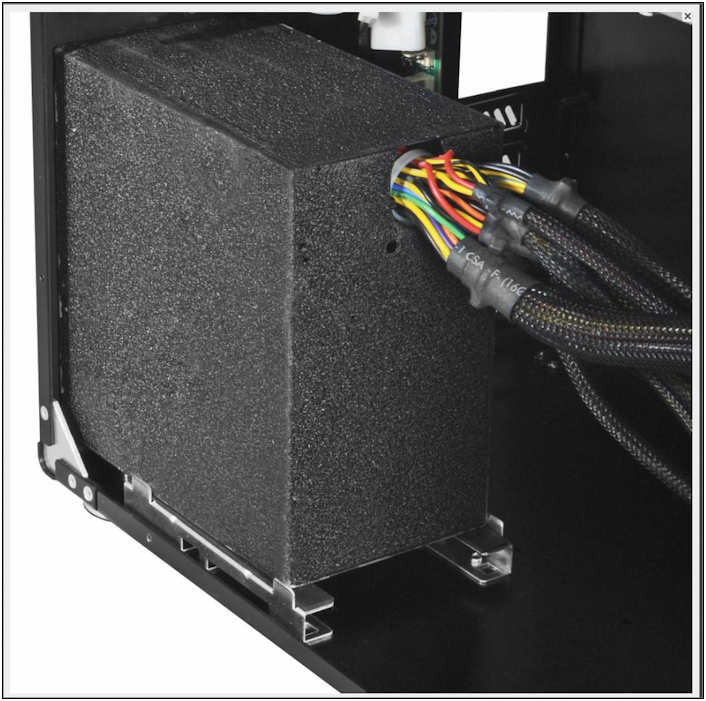
The Build
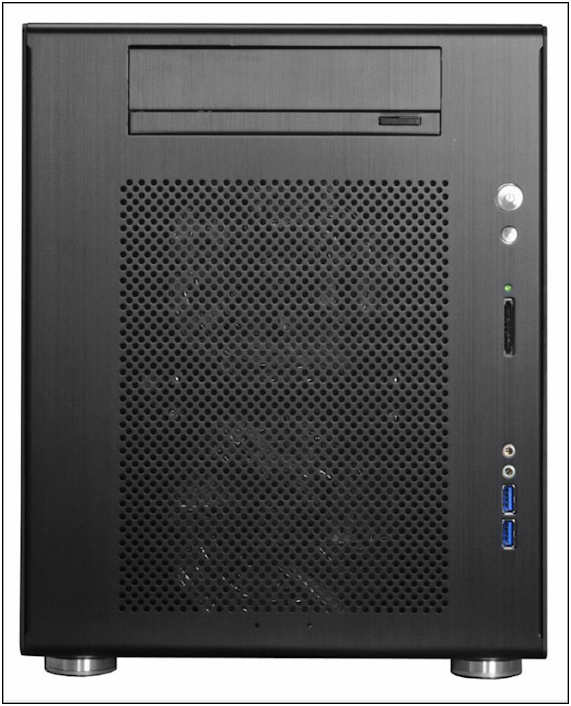
The first thing you’ll want to do is remove the 8 screws from each side panel and set them aside. Then remove the two drive trays which gives you access to the optical drive bay.
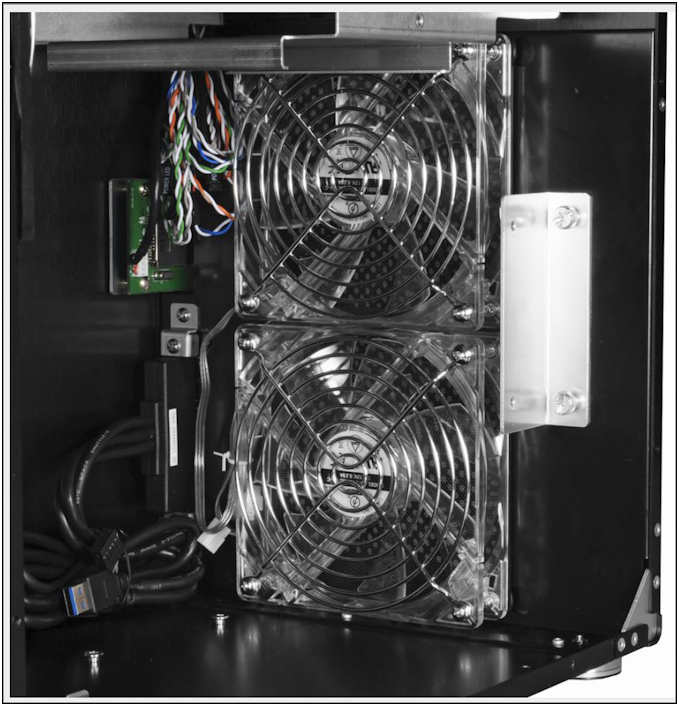
Remove the bay and mount your optical drive. I can overlook the need to remove the two drive trays to mount the optical drive because an optical drive isn’t something we replace often if at all. It’s important to note that adjustment of the optical bays position in the bay is critical to smooth operation of the external ‘push down’ door. Once adjusted it operates flawlessly.
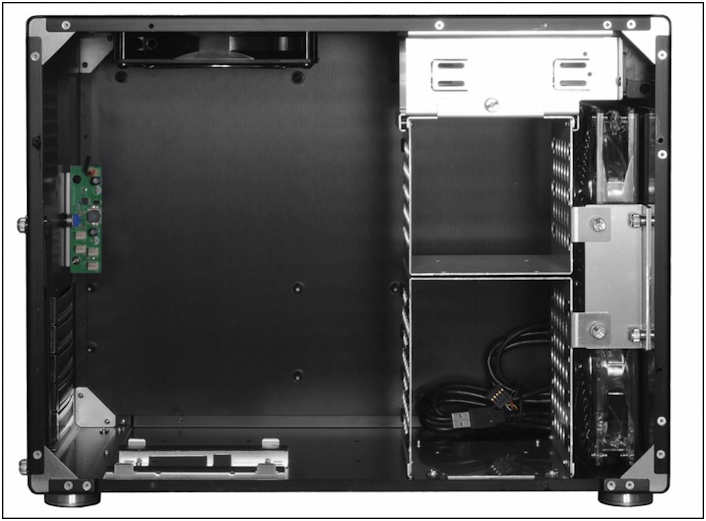
Next, take the left side you set aside and you’ll notice there are mounting bosses welded on to mount your motherboard. Go ahead and mount your motherboard, CPU, RAM, and CPU cooler. At this point you’ll want to connect as many of the front panel switch and port connectors as possible. Be sure to attach the motherboard port insert into the back plane of the case. When the motherboard is mounted and the wires connected, reassemble the side panel to the case.
Mount your video and any PCI cards at this time.
Lian-li includes a nice legend for this purpose, but for some reason this time they omitted the pin layout of the front panel switches. They’re marked on the wires themselves, but unless you know the white wire is ground you could make a mistake. They need to include the legend.
At this time you’ll need to make a choice whether to connect the four case fans to the motherboard fan connectors and let the motherboard BIOS control the fans, or alternatively you can connect the case fans to the included fan controller on the rear, and adjust their speed using the adjustable rheostat.
Now you’ll want to mount your drives in the drive trays while they’re still out of the case. Use the included rubber bushing screws for vibration and noise free operation. Once your drives are mounted assemble them back inside the case and run your SATA cables to your motherboard.
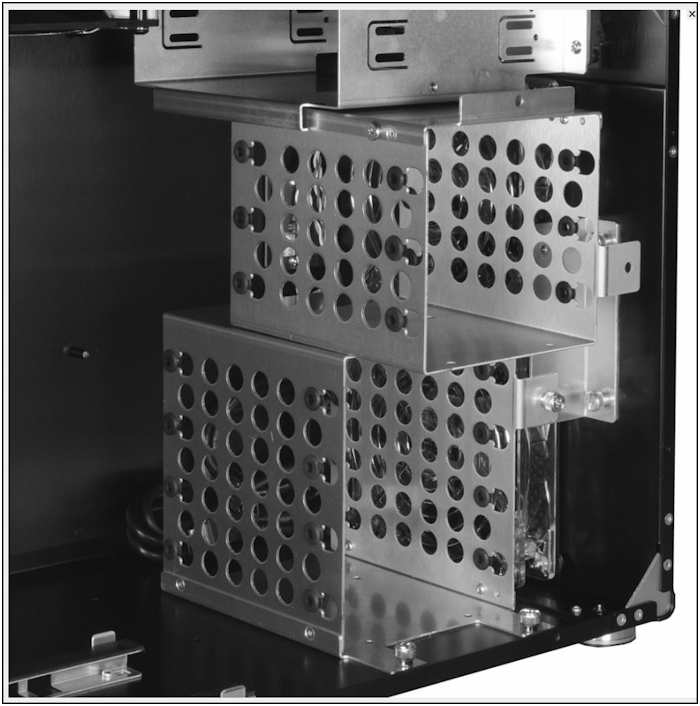
Finally you’ll need to remove the four thumbscrews holding the power supply mounting plate to the rear of the case, and then use the included four screws to mount the plate to the power supply. Once this is done, carefully place the power supply into the case setting it on the rubber cushioned rails, and secure the mounting plate to the rear of the case using the same 4 thumbscrews you removed earlier.
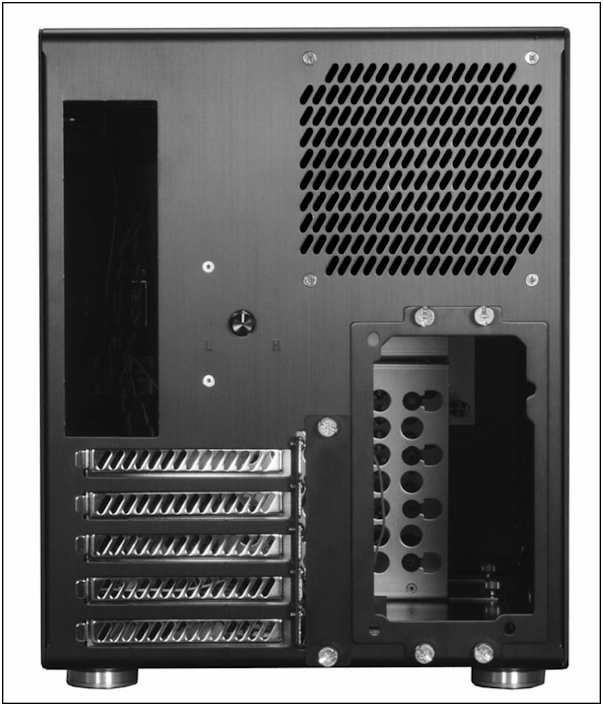
Now all that’s left is to plug in the power connecters to the motherboard, fan controller (if used), optical drive, and any SSD’s or HDD’s you installed. Finally, if your video card requires a power cable plug it in now.
You’re finished. Reassemble the last side panel and snug up the 8 screws.
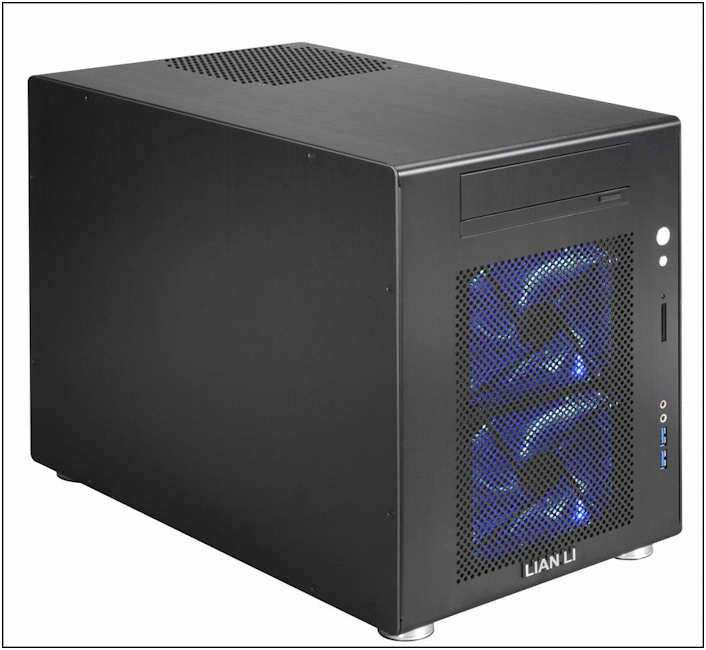
Performance
There are really only a few areas regarding performance to consider with a case.
- Fit and finish, sharp edges, paint, etc
- Design, ease of assembly
- Operation of ports and switches
- Acoustics, how much noise it generates
- Thermal efficiency. How well it cools
Fit and Finish
I’m pleased to say the Lian-li PC-V354 didn’t have a single sharp edge, and all panels and trays fit exactly as they should.
Design
The design is generally excellent, but I think the power cables on the case fans could have each been about 6-8 inches longer, and the front panel USB3.0 internal cables another 3-4 inches longer. I own several other Lian-li cases which require absolutely no tools for assembly, so I understand the 8 screws on each side panel and the traditional screw hold downs on the expansion card slots are necessary to keep the side and weight down. Still, I wish they could find an alternative to those eight screws on the side panels.
We should also note that there are washable filters on the bottom air intake, and the front fans can be easily removed for cleaning as necessary. The case isn’t “dust proof”, but they did attempt to make dust less of an issue.
Operation of Ports and Switches
Flawless. The USB3.0 ports appear to be high quality and should last the life of the case, and the same can be said for the soft touch switches. The SD card reader works well with cards I tried up to 64gb in capacity and installed without any special drivers required. As I mentioned before the external ‘case matched’ door on the optical bay required some adjustment, but afterwards worked flawlessly as well.
Case Acoustics
I’m not at all fond of loud white noise generated by cheap fans, and even worse are errant vibrations caused by poor mounting design. I’m pleased to say the Lian-li PC-V354 case, even at the highest case fan speeds, was totally silent even when sitting on a table top 2 feet from my ears. And my ears work great.
Unfortunately I can’t say the same about the fans on power supplies and video cards, so if a truly silent computer is your goal, choose the power supply and video cards carefully.
This case and it’s fans produced no audible noise or vibrations. It was like driving in a Rolls Royce.
Thermal Efficiency
This is an area where every small case I’ve ever tested lets me down. It always happens, shove a bunch of heat generating high performance PC parts in a small case, attach the sides, and it ends up running very hot with premature parts failure.
Not this time! I installed a 1366 socket 130watt high power i7 CPU, 6 banks of high-speed RAM, a single powerful video card, and several hard drives, and the temperatures remained very reasonable. CPU temps are roughly 38-42c on idle, rising to less than 60c under full load. This is spectacular for such a small case and shows the thoughtful and innovative design.
Summary
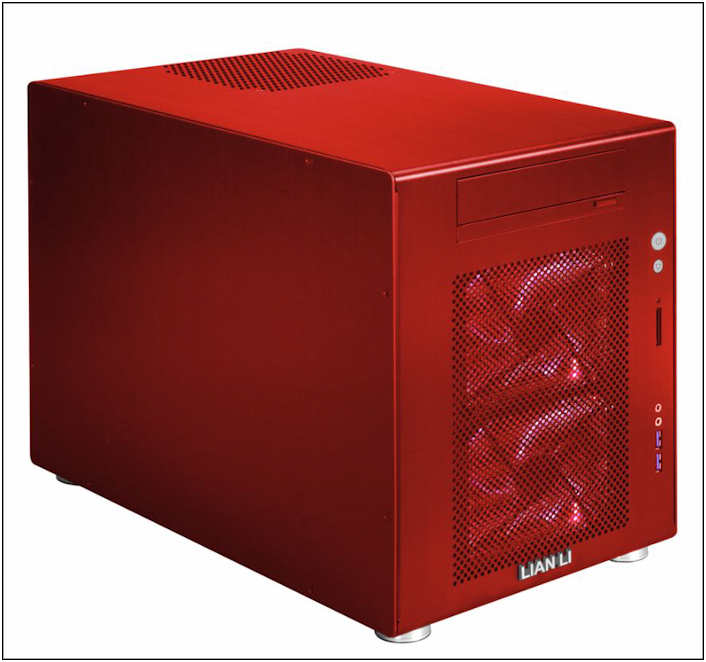
This is a great case. It’s small, lightweight, holds a full size power supply and video cards, mounts up to 24tb of HDD storage as well as several SSD’s. The case ports directly support USB 3.0 and the most modern high capacity SD cards.
Performance is generally excellent and there are only a few areas of improvement needed to make a perfect case. Such as a dimmer for the case fan lights..
Quiet, stylish, small and powerful.. Perfect if these are your requirements.
Photography News of Interest *menu
SanDisk announces the world’s fastest high-capacity compact flash card. 128gb’s at 100mbps is more capacity and faster speeds than many computer SSD’s! Powered by the latest UDMA-7 interface this promises to be a leading card for those recording tons of video and still images.

Apple has reduced the price of their Aperture image management and RAW file conversion software to just $79 USD’s. If you’re a Mac user you’ll want to take advantage of this great price. It integrates nicely with Iphoto.

Olympus introduces the SP-610UZ Superzoom, a 28-616mm (35mm equiv) lens, 14mp’s, 3” LCD, and even 3D images. If you’re interested in the superzoom genre give this a look.

A rare John Brown daguerreotype print sells for $97,750. John Brown wasn’t the photographer, he was a free state activist who raided a federal arsenal back in 1859. There were only 8 pictures known to be of the man. You’ll want to carefully check your families old photos before disposing of them just in case..

Julian Lennon, John Lennon’s oldest son is now a photographer as well as a singer. He developed his interest during a tour of Eastern Europe with his brother Sean. Landscapes through celebrities. Check it out.

Readers Submissions *menu
Hi BKKSteve,
As a regular reader of your column I was thinking I sent you a series of pictures taken myself. These were taken over the last couple years and are considered my best so far. They are specific about SE Asia or Thailand… just of random events and travels.
I would like to ask you to review and comment them and give me some tips and hints on how to improve my further photo's. Photography is a hobby and I would like to improve my work. Current equipment is a Cannon Eos 450D and I am satisfied with this camera. I have the standard lens ( 18/55 ) and the ( 55/250 ) lens.
If you like to run them in your column please ask in advance as I am not sure the people on these pics would agree to this.
Thanks in advance and keep up the good work on your column.
Greets Bart B.








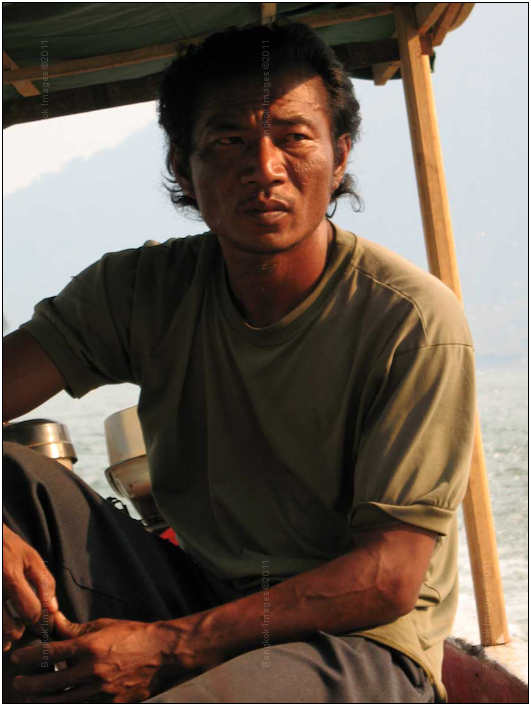
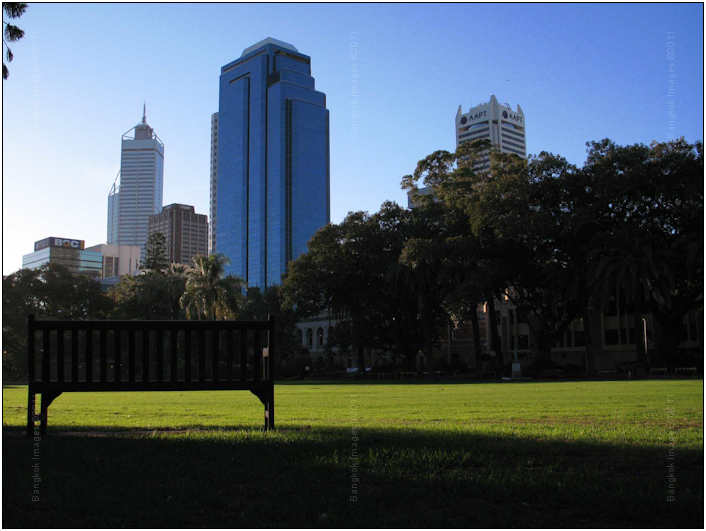
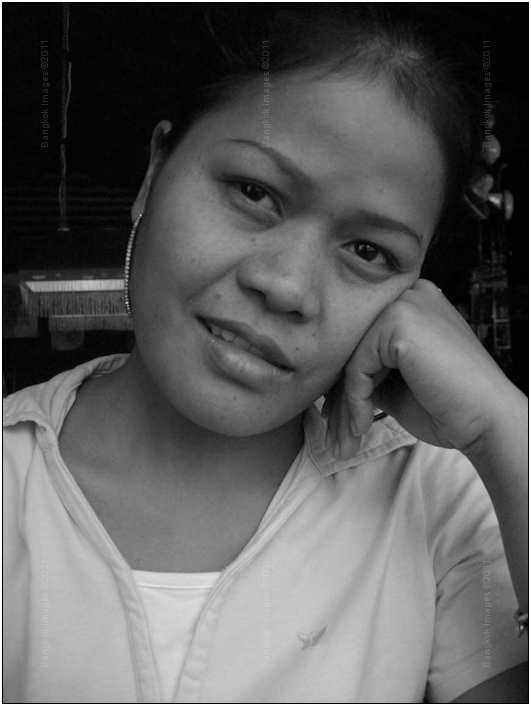
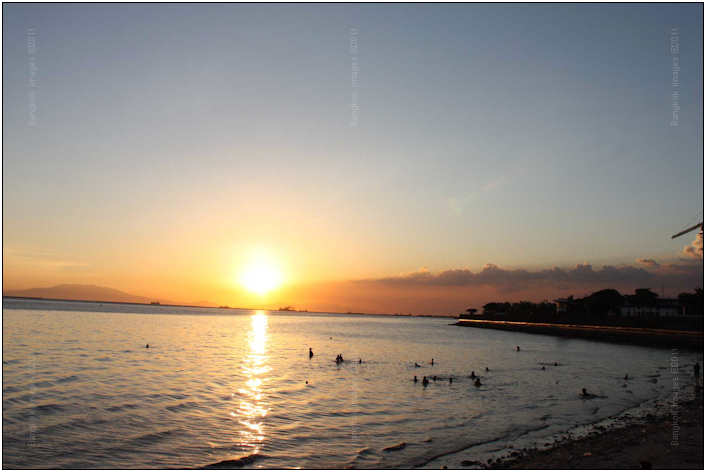
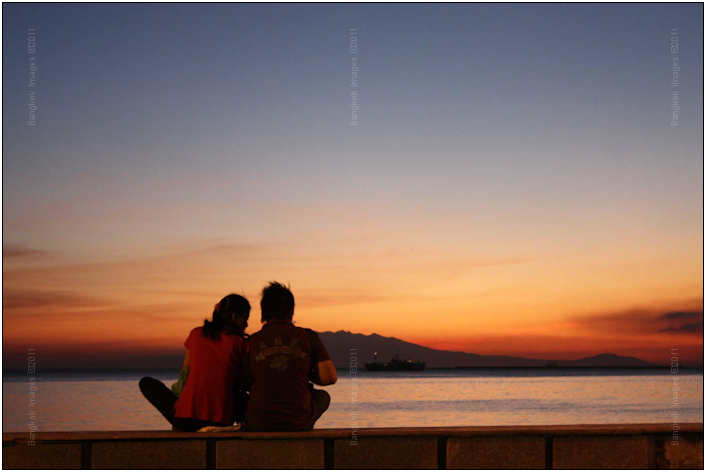
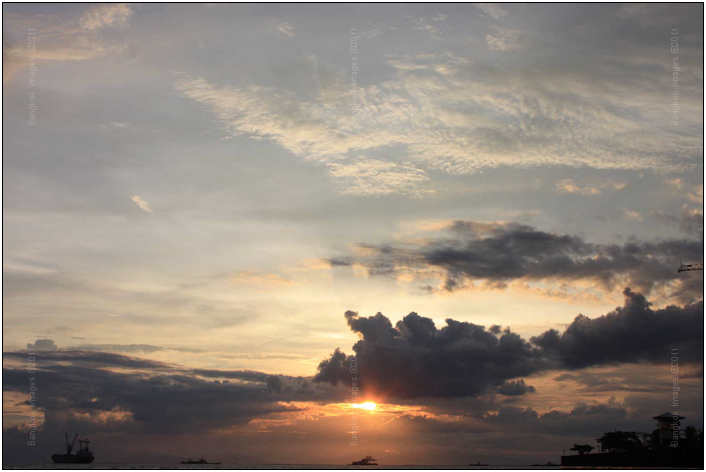
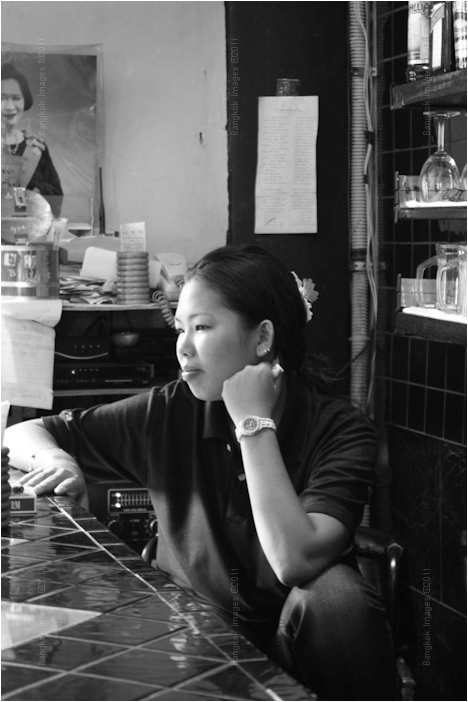


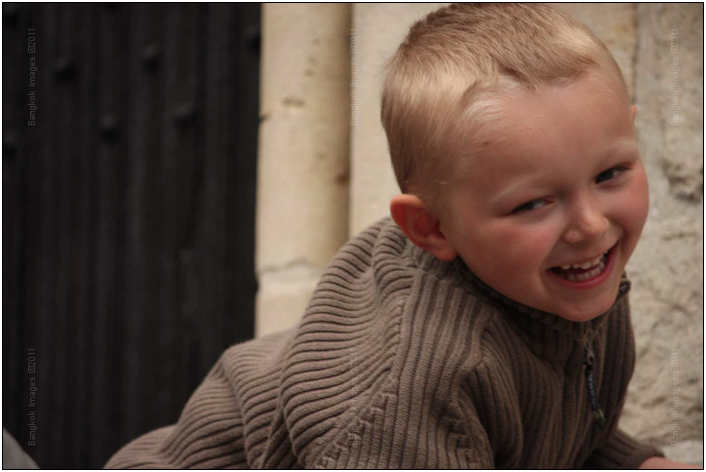
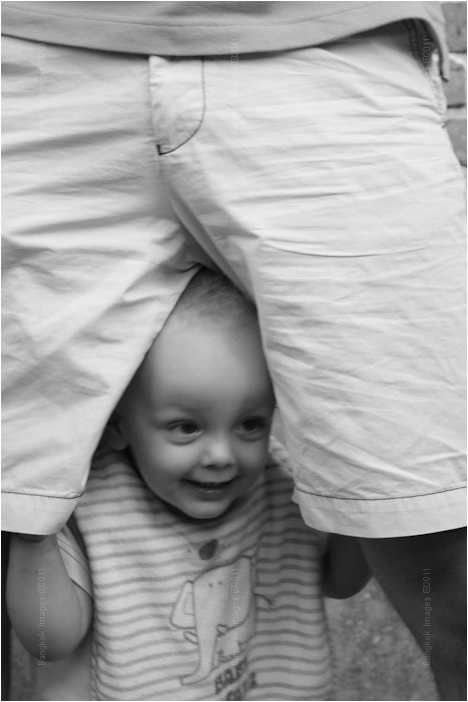
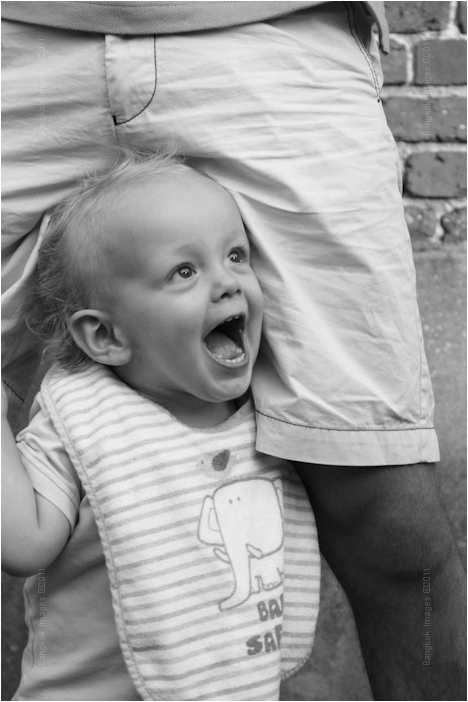
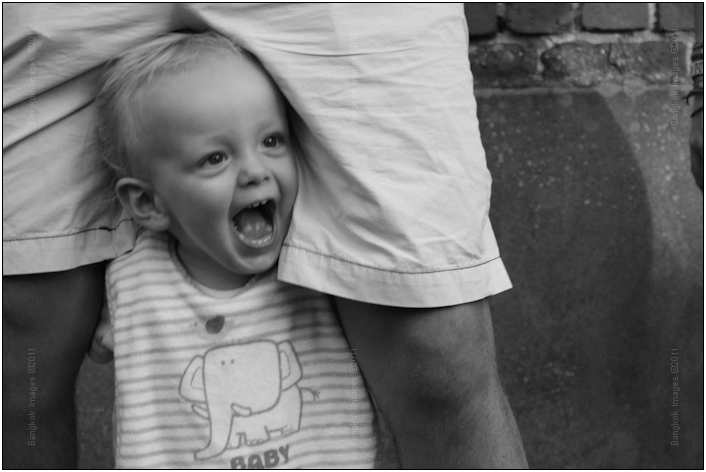
Hello Bart –
Thank you for the feedback on my column and I'd be glad to comment on your images. Please realize I'm being very honest and that it's only my opinion. And yes, I'd love to run these (and the comments if you wouldn't mind) with your permission.
pic1 – I like this and the shallow DOF, though I think it would be stronger if the mother and boy were more engaged.
pic2 – This I like very much, though technically it should be sharper, especially in the eyes. I have one of a small girl almost exactly the same, same crop, same look, etc.. one of my favorites.
pic3 – I don't like this. The hand kills it for me. Cropped differently I might have a different impression. The image quality is great though, nice and sharp and the skin tones seem to be spot on.
pic4 – Outstanding! Great feeling, engaged, love the shallow DOF, the eyes show love of his art.. very nice!
pic5 – I hate everything about this one. Poor image quality, not very interesting subject, underexposed, etc.
pic6 – This makes me smile.. I do wonder how much of the mans shorts we need to show to convey the boys location.. would rather crop some if possible and bring the face out more.
pic7 – This look unfortunately is quite common.. the boys face is underexposed.. but exposing his face properly means the background would be overexposed.. a great subject, but the photo doesn't work for me.
pic8 – Too small and too poor image quality (copy quality) to judge.
pic9 – I like this one.. the side light on his face, look, the crop is tight yet you can tell he's piloting a sampan.. his face is a bit soft though.
pic10 – Poor image no matter how you look at it.
pic11 – This is an okay image.. but it's missing context. The technical's are good, the content is lacking.
pic12 – Again, a poor image from every respect. I understand what you were trying to do but you didn't pull it off.. a missed opportunity.. and it didn't need to be..
pic13 – Wonderful! Love this. I think it could be improved by straightening the horizon (use the wall as a guide), and cropping out some of the nulls space (sky)..
pic14 – Totally uninteresting.
pic15 – Very good. This captures the feeling very well, shows a bit of interesting background, love the queens picture on the wall..
pic16 – Not interesting.. Very soft subject, not an especially interesting expressions, and the image could be processed to set the subject apart from the background better.
pic17 – I want to like this.. but the expression lets it down.. maybe if you'd backed out to show more of the scene so context would come into play?
pic18 – The boy is engaging.. but I think this good looking boy could be photographed much better.. Photograph in context, show less null space, and use processing to your advantage.
pic19 – I like this one very much. An innocent expression on the small boys face as he peeks out from between his father’s legs. The composition is well balanced and the image is fun.
pic20 – This one while close, doesn’t hold the same feeling for me. The composition feels unbalanced and the expression more severe.
pic21 – The crop on this one is much better balanced, but I’m still not fond of the boys expression. Of course this, as are all of these comments, only my personal observations.
Btw – Your English is great!
My son uses the same body and lenses you're using.. and they're not that easy to get great images from. I gave him this body and these lenses specially to make getting a good image more difficult for him.. to make him concentrate on other aspects of photography. Still, occasionally he turns out a real winner.
It was great hearing from you. Please, any time you have a question or want to contribute we'd love to hear from you.
Steve
I suspect the readers submissions will be a highly anticipated section of this column and I encourage anyone with photographs and travel accounts they'd like to share to please send them to me at: info@BangkokImages.com
Readers Questions *menu
Hi Steve,
As the topic of this email states I am considering of buying some new lenses which are a substantial upgrade/replacement to the kit lens (EFS 18.55 f3.5-5.6 IS ) that came with my EOS 450D. I have been doing some research on the internet and I narrowed it down to 3 possible options which I consider buying. My question to you what do you think about those lenses. I am sure they all a good upgrade but which one would be the best. My interests in photographing are all round and I do prefer to shoot without having to use the flash and even in low light conditions.
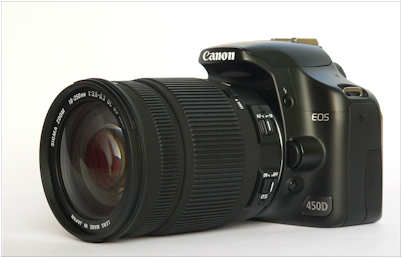
These are my three chosen options :
Canon EF-S 15-85mm F3.5-5.6 IS USM
Canon EF-S 17-55mm f/2.8 IS USM
Sigma DC EX 17-50mm F2.8 OS HSM Canon
Secondly what would you suggest to upgrade the EFS 55-250 f4-5.6 IS lens, bought separately with?? Any ideas or suggestions are very much welcome here. So far I am considering the following option :
Canon EF 70-300mm f/4-5.6 IS USM
Thirdly : Do you think it is worth the money for buying a good upgrade for the lenses and still use the EOS450D in combination with those lenses. One shop owner told that I might be better off buying also a newer camera model and look for a kit that comes with one those better lenses. What do you think about it?
Thanks in advance and looking forward to your reply. Keep up the good work on the site.
Greets Bart B.
Hello Bart B.–
Regarding the lens choices. You’re telling me two things.
a. You desire low light capability.
b. You might upgrade your body in the future.
With this in mind you need to consider if you want to stay with EF-S lenses (those lenses made specifically for the 1.6x APC-S sensor camera bodies), or if you’ll upgrade in the future to a full frame body. Full frame bodies are much better in low light and many end up getting there the long way around (buying several crop frame bodies while trying to keep costs down) so you need to consider this very carefully if low light is your goal. Lenses last a lifetime if well cared for, so you’ll want to be sure you won’t need to replace them.
If you stay with a APC-S 1.6x crop frame sensor DSLR, I think the 18-55mm F2.8 IS is a good choice. I haven’t any experience with the Sigma, but I have read some reviews and looked at the MTF tables and I wasn’t impressed.
You might also want to consider a 50mm F1.4 lens. The difference between F1.4 and F2.8 is huge when you’re talking low light. Other primes for low light would be the excellent 35mm F1.4L (pricey and big), the lightweight but surprisingly inexpensive and very sharp Sigma 20mm F1.8, and even the e 100mm F2 if you need the focal length. When you’re talking “low light” you want the largest aperture you can afford in terms of dollars, and size/weight.
About your 70-300 choice. There is one I regularly recommend for those who want a smaller lens and want to keep it small and light. The 70-300mm F4 DO IS. It’s a bit pricey, but used properly it’s a very effective lens. As it goes, most people who buy this lens find it produces better and better results as they gain experience using it. This is because a small light lens of this focal length takes a lot of practice/technique to hold still enough for sharp images. If you can stand the weight/size, consider the 70-200mm F4L IS.. a superb telephoto. The full size 70-200mm F2.8L IS II is a great lens too, but probably too big and heavy for your uses.
About your camera body. Given the choice, I’ll almost always spend money on lenses first and bodies second. A good lens will significantly improve the images from ANY body. With that said, the 450 is a bit dated and you’d see significant gains going to something more modern. Again, for your uses consider full frame which would be the 5d Mark II or a good used original 5d.
Steve
Hi Steve
Thanks for your opinion and thoughts about the lenses I consider buying. This will help me to make my decision but also raises the question if I need to consider buying a FF Camera in the future. Still not sure about that though… A FF body still is a lot money and I am not sure if I want to invest that when I am a small hobby photographer.
Bart B.
Hi Bart –
A ff body is a lot of money, but so are lenses.. and buying lenses twice at a later date is very common and even more expensive. Don’t be afraid to buy a good used model either. The original 5d can be had for about $1000.. and even the professional level 1ds2 for about $1500. That’s a pro level body, 16mp full frame sensor, pro level autofocus and metering.. a lot of camera for the money.
These are all tough decisions.. I see many make them every week.. and I think it comes down to this: If you see yourself still enjoying photography five years from now, then consider a FF body and a couple nice lenses. You’ll get great enjoyment from it. If photography is a once every few months activity, the maybe look at the new 60d.. it’s a great camera too, but far more affordable.
Take care
Steve
Steve
I am still not sure if I really want to spent the money on the better lenses for my EOS450D…
I mentioned in the first email that one shop owner told me that the lenses I was talking about, would be a waste of money as the used camera body was not that good enough and it would not be able to bring out the best of the said lenses.
Last night I had a little talk with a friend about my ideas. The said friend here was a pro photographer in the past ( dating the film and not digital period ) and he also mentioned to me that those better lenses would not be ideal for the camera. The lenses would be too good in quality and I would not get that out the camera I have. In short he called it an overkill and waste of the money. He would advise me to seek out techniques and a better understanding of how to use the equipment that I have at this moment.
As he mentioned that my motivation in choosing lenses with a smaller F-number are a bit wrong too. I am thinking that it would give me an advantage of shooting in low light conditions. He’s answer is that Pro photographers are not considering this but use the ability to better control the DOF and because it gives them a better and nicer blurred background and bringing the subject more out of the background.
My question here is, are my reasons and motivations to upgrade the kit lenses wrong? Am I thinking of getting advantage which and I won’t get with upgrading the lenses I have now? What is your opinion?
Greets Bart B.
Hi Bart B. –
I’m about ready to take off for a few days so I thought I’d better answer this now before l leave.
Instead of addressing the exact information the others gave you, allow me to talk about the subject in general and then finish with my professional opinion. The photographers skill is paramount, the most vital part of the system. The three EF-S lenses you were considering are not professional quality lenses. They’re merely nice lenses for an APC-S body
The better the lens, the better image from ANY camera body.
A given sensor (the image part of the body) has a theoretical limit, and a practical limit concerning image quality.
A given lens also has a theoretical and practical limit.
In the order of importance in achieving a high quality image would be: subject, light, photographer, lens, body. Notice the body is last.
It is always preferable to have a better lens than a better body.
Concerning fast (large aperture) lenses. A faster lens can indeed provide a more shallow DOF. DOF is mathematically calculated from four variables: Sensor size, Aperture, Focal length, Focal Distance. As sensor size/focal length/aperture increases DOF decreases. The less focal distance, the more shallow the DOF.
A faster lens (large aperture) is ALSO beneficial in low light, but DOF must be considered when using a large aperture even in low light. In other words: A larger aperture (say F1.4) will allow you to photograph in lower light, but at the same time it also results in less DOF.
Professional photographers consider BOTH DOF and low light capability. Remember, photography from a technical standpoint is nothing more than balancing the available variables. ISO, Shutter speed, aperture, focal length, focal distance.
Now my opinions:
A workshop, online lessons, a good book, are all preferred for improving photography over new or different equipment. Workshops provide the most gain in the shortest time, and therefore you could argue are the most cost effective.
For your needs you want a FF body. Until you can budget one,, the body you have is perfectly serviceable.
For your needs large aperture prime lenses would be best. These can be used on your current body, and can be used more effectively on a future FF body. They will improve ANY body you use them on if they’re quality lenses.
A quality lens is forever. Buy the very best lens you can afford every time, make sure it supports the FF format (every non-EFS lens), and you’ll be able to use it the rest of your life and it will still be a valuable item to pass down to your kids. For instance, I paid nearly $2800 for my Canon 300mm F2.8L IS lens. People said I was crazy. I’ve used it heavily for over ten years. The current used price is approaching $5000. Not a bad investment. All my quality lenses have appreciated. Mediocre consumer lenses will lose their value rapidly.
Bart, it would be nice if you could budget a new body AND new lenses.. but not everyone can do that. Most must make a choice. From a standpoint of pure image quality your current body is fine until you upgrade to FF. From a feature standpoint you ‘might’ be better served with a newer crop frame body, but only you (or your workshop instructor) will be able to know this by helping you achieve your goals.
Once of these days I’m going to buy a roll of film for my great grandmothers Baby Brownie that has no controls other than a shutter button, a plastic lens element (one only), and cost $1 new. And then scan the resulting negatives to provide a better quality image than most of these online experts have ever seen. Don’t get me wrong, I love digital cameras. But film vs. digital is just another variable you balance to get the job done.
I hope this helps. Keep asking me questions until you’re satisfied you understand what you need to make your next purchase.
Steve
Hi Steve,
I just wanted to thank you for your very quick reply. I am sure it will help and make a decision. I will probably have some more question but I will send them to you later.
Enjoy your few days off and thanks again for your quick reply.
Greets Bart B.
Please submit your questions to info@BangkokImages.com All questions will be answered and most will show up in the weekly column.
A Snapshot of Bangkok Images Week in Review *menu

This week we had only a single workshop and no assignments. I’ve used this extra time productively to trace down two long standing issues with www.bangkokimages.com, an issue affecting the submission of comments after the article entries, and issues with the User Galleries not functioning correctly. Both are now repaired. It turns out the rotating image header of the site was interfering with both, so this has been replaced with a new flash based header. For all intent and purposes it should look and function the same from a user perspective. However, there is still a small issue preventing proper display of this banner when using certain versions of Internet Explorer and we’re working on this.
This week I’ve built an exciting new very small footprint powerhouse workstation which I hope to bring you a review of next week, last weekI reviewed the blazing fast OCZ PCIe SSD card , and soon a gaming NIC for that extra edge when gaming online, a ATI 5970 video card, and NEX LCD2690uxi2 imaging monitors..
The User Galleries on www.bangkokimages.com are growing
and there’s a lot of interesting images to check out.
The User Gallery of the week is Khun Klit’s“Pattaya-December 2009” gallery. Really good street pictures with lots of color and fun feelings! Check it out.
Positive comments continue to pour in about our new look and much faster more interactive site. If you haven’t already checked it out, visit www.bangkokimages.com
to see my latest galleries, share your own galleries, participate in the forums,
and scour our large repository of photography related articles. The “What’s New
” page continues to be very popular with almost daily updates and interesting content.
Infocus Blog, CES 2011 *menu

This week the biggest news is the Consumer Electronic Show (CES) which I've been closely following. This year’s big news are the new Sandy Bridge Intel CPU's which include a video card on the CPU chip itself which is
fairly competent, uses much less power, and for mainstream PC's will become very popular. The neat thing is you can still have a laptop or desktop with a discrete video card for gaming or work, and the system will know when to switch between
the onboard low power video, and the higher power discrete card. Great new technology. Less power means less heat.

Other big news are the recent announcements of some very fast SSD's in the 2.5 inch (laptop size) form factor. Previously they've been limited to a max of about 350mbps read and 200 mbps write like the Crucial C300 we reviewed
last year. In the next year this same form factor will push speeds in excess of 500mbps for both read and write! I wonder where it will stop?

The Consumer Electronic Show (CES) is the biggest international show of new electronics of all types in the world. Manufacturers the world over prepare products timed to be announced at this show because of the exposure they’ll
gain. The best advertising available.

Last Years CES story was 3D televisions. Since, it's all we've heard about. This year they're pushing 3D content and 3D accessories as more affordable and stylish, 3D glasses especially. The 'next generation' of 3D televisions
aren't out yet, so we're still on 3D TV v1.0. But perhaps for CES 2012..

Camera manufacturers usually don’t heavily promote DSLRs and other professional equipment, but they sure to use CES to promote consumer compact point and shoots. This year we reach a milestone as name brand models such as Sony, Canon, Nikon, and
others market competent point and shoots UNDER the $100 price floor. Before, we could occasionally find a refurbished or generic brand P&S compact near this price, but this year will be the first time major brands are under $100. Do you think
they’ll ever reach the $1 price of the original Baby Brownie?

Last year the Ipad took the market by storm. Computers have been downsizing since their introduction. For many years various formats of laptops have replaced legions of bulky often hideous looking desktops as living room and dens the world over reclaimed
the space they occupied, but lately the ubiquitous laptop has been under siege by Apple’s Ipad. This year the Ipad is being challenged by a host of new tablets sporting Android and Windows 7 mobile operating system. This next year will
be the year of the tablet PC’s.

Some manufacturers like Dell and Lenovo, two of the biggest names out there, used CES 2011 to introduce and showcase the “convertible PC”, what seems like a normal laptop with both a screen and full keyboard, which has a detachable screen
which can serve alone as a tablet PC. I personally think this is brilliant if they find the right power vs. price point for the majority of consumers.

Every CES has a star of the show, and we often don’t agree on who this star is. Some are proclaiming the tablet PC’s, others 3D accessories/content, and still others think it was the crazy fast SSD’s we’ll see early next year.
I think it’s the Sandy Bridge CPU’s. They won’t affect the high end workstation user much, but scores of laptop and entry-mid level desktop users will benefit. Watch in the coming months as Sandy Bridge CPU equipped machines
are marketed at full tilt proclaiming miracles of computing.

In truth they’ll replace most if not all of the laptop CPU’s, and all but the high-end desktop and server class workstation CPU’s. This means they’ll be everywhere! “Sandy Bridge Compatible” will be the next Intel
sticker we’ll be looking for on the outside of personal computers of all types.
We really love in good times.
Until next time.





